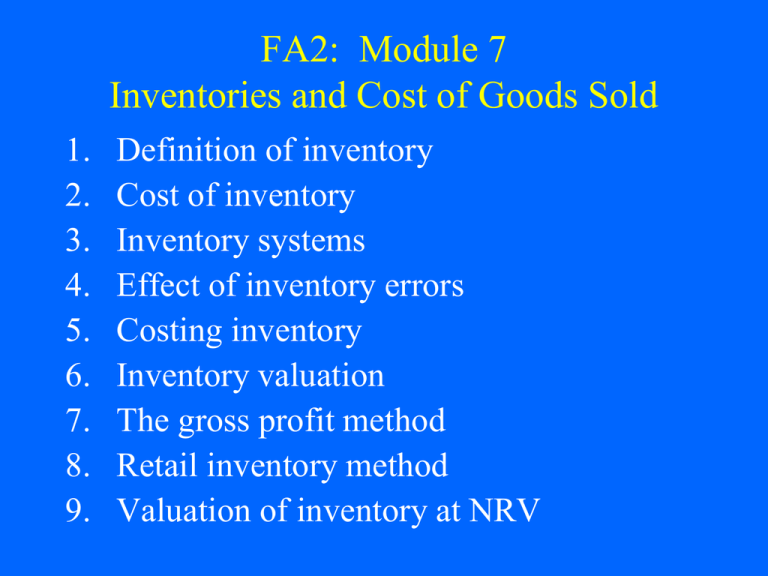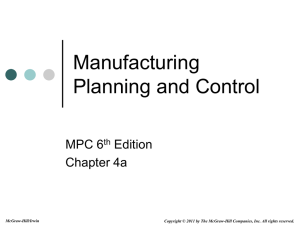FA2: Module 7 Inventories and Cost of Goods Sold
advertisement

FA2: Module 7 Inventories and Cost of Goods Sold 1. 2. 3. 4. 5. 6. 7. 8. 9. Definition of inventory Cost of inventory Inventory systems Effect of inventory errors Costing inventory Inventory valuation The gross profit method Retail inventory method Valuation of inventory at NRV 1. Definition of inventory Inventory includes goods awaiting sale, goods in various stages of production and supplies. Inventory is a current asset. Type of firm Manufacturing Composition of inventory Retail/wholesale Raw materials, work in process, finished goods, supplies Merchandise, supplies Service Supplies Inventory definition problems Any inventory items held for resale or use by company should be included in inventory if it is owned by the company, regardless of location: -items out on consignment (held by an agent who pays for items only if they sell) -purchased items in transit that are FOB (free on board) shipping point -sold items in transit that are FOB destination Inventory definition problems (cont’d) The following items should be excluded from inventory: -items belonging to another firm that are held on consignment -purchased items that are awaiting return to vendor for credit -items purchased with a repurchase agreement, when it is likely that the items will be returned 2. Cost of inventory Inventory is initially valued at historical cost, which includes all costs necessary to acquire the inventory and prepare it for sale (laiddown cost); plus transportation. (e. g., A8-1) Type of firm Retail and Wholesale Items included in cost of inventory Purchase price less discounts, sales tax, import tariffs, packaging, transportation Manufacturing Cost of raw materials, direct labour cost, factory overhead 3. Inventory systems Periodic inventory system System of recording inventory-related transactions (purchases, sales) wherein Inventory and Cost of Goods Sold are updated only once per period. Perpetual inventory system System of recording inventory-related transactions (purchases, sales) wherein Inventory and Cost of Goods Sold are updated after each inventory-related transaction. Bookkeeping: Periodic vs. perpetual systems Event Purchase Sale Perpetual Dr. Inventory Cr. AP Dr. AR/Cash Cr. Revenue Dr. COGS Cr. Inventory Physical count Dr. Inv shrinkage of closing Cr. Inventory inventory (if necessary) Periodic Dr. Purchases Cr. AP Dr. AR/Cash Cr. Revenue Dr. Inv (ending) Dr. COGS Cr. Purchases Cr. Inv (beg.) Inventory vs. cost of goods sold Beginning inventory + Purchases or Goods manufactured = Cost of goods available for sale = Cost of goods sold + Ending inventory 4. Effect of inventory errors Inventory errors affect both the balance sheet (inventory is misstated) and the income statement (COGS or inventory shortage is misstated). Inventory errors are counterbalancing (reverse over time). Year 1 Year 2 Beginning inv OK Error + Purchases OK OK -Ending inventory Error OK = Cost of goods sold Error Error Effect of inventory errors (periodic) This year’s financial statements Ending inventory overstated Next year’s financial statements COGS understated COGS overstated Inc overstated Inc understated Assets overstated Assets OK Ending COGS overstated COGS understated inventory Inc understated Inc overstated understated Assets understated Assets OK Example: Storm Company Year 1 Year 2 Sales $120 $131 Cost of goods sold 96 76 Other expenses 20 20 Net income 4 35 Retained earnings, January 1 47 51 Retained earnings, December 31 $51 $86 Year 1 ending inventory was understated by $12. The error was not discovered until year 2. Storm uses a periodic inventory system. What is the effect of the error on income and cost of goods sold? 5. Costing inventory (and COGS) a. Specific identification b. First-in, first-out (FIFO) c. Average cost Example: A8-25 a. Specific identification Definition: Keep track of each item in inventory (e. g., by serial number). Identify each item sold (and its cost) to determine COGS; identify items left in inventory (and their costs) to determine ending inventory. Comments: •best possible matching of revenue and COGS but vulnerable to manipulation by management •administratively cumbersome •used for valuable and easily identifiable merchandise b. First-in, first-out (FIFO) Definition: Assume that oldest units in inventory are first ones sold (e. g., perishable goods in a grocery store). Comments •“Favours” the balance sheet: Most current costs are included in cost of inventory, while oldest costs are in COGS. Net income is therefore (perhaps) less relevant. •Eliminates opportunities for income manipulation by management. c. Average cost Definition Compute one average cost figure for all units of inventory = total cost of goods available for sale divided by total number of units available for sale. COGS = units sold X average cost. Inventory = units left X average cost. Comments •Single, convenient, cost 6. Inventory valuation: Lower of cost or net realizable value Historical cost vs. market value Historical cost is one of the basic principles of Canadian financial accounting. Historical cost is abandoned, however, when the future utility (revenue-generating ability) of the asset is no longer as great as its original cost. For inventory, market value is generally taken to be net realizable value, expected selling price less predictable completion and selling costs. Applying the lower of cost or NRV rule 1. Determine cost using acceptable method 2. Compare the cost to net realizable value and adjust carrying value if necessary The lower of cost or NRV rule is usually applied on an item-by-item basis, but can be applied on a category-by-category basis if goods within category are very similar. Previous writedowns should be recovered as reduction in COGS, although amount of recovery must be disclosed in notes. Lower of cost or NRV: Bookkeeping 1. Direct method If NRV < cost, ending inventory is recorded at NRV. Any valuation loss is buried in Cost of Goods Sold. 2. Indirect (Allowance) method Ending inventory is recorded at cost. If NRV < cost, a valuation allowance (contra-asset account) is established to record any decline below cost; and a loss is recorded. Lower of cost or NRV: Bookkeeping 2. Indirect (Allowance) method • The valuation allowance is only adjusted once per period • The valuation allowance can never have a debit balance (i. e., inventory cannot be written up to some value greater than its cost) Example: The allowance method Assume allowance Account balances at Dec. 31, balance is 0 before 2011 2012 2013 2014 Dec. 31, 2011 Inventory @ cost $900 $700 Inventory @ NRV 850 730 Req’d allowance Adj to allowance Increase (decrease) in income $800 $700 770 680 Lower of cost or NRV example A8-8 7. The gross profit method On occasion, estimation methods are used to approximate inventory on hand. The gross profit method is one of these and is usually not acceptable for annual financial statement purposes. However, it is useful when a physical count of inventory is impractical or impossible, e. g.,: -interim financial reports -Estimates of damaged or lost inventory The gross profit method: Nuts and bolts Beginning inventory BI + Net purchases P Goods available for sale (at cost) BI+P Net sales (at selling price) REV Less gross profit GP= % x REV - Cost of goods sold REV-GP Approximate inv. (at cost) BI+P – (REV-GP) *Assumes it is possible to estimate GP%. Example: A8-21 8. The retail inventory method Basic steps 1. Determine cost of goods available for sale at cost and retail. 2. Compute cost ratio (ratio of cost to retail value of goods available for sale) 3. Compute closing inventory at retail (goods available at retail, less sales) 4. Compute closing inventory at cost (closing inv. at retail X cost ratio) Markups and markdowns Markup: initial amount added to cost to determine selling price Additional markup: increase in selling price above original selling price Additional markup cancellation: Cancellation of some or all of additional markup Markdown: Reduction in original sales price Markdown cancellation: Increase in sales price after markdown (not above original sales price) Markups and markdowns and retail method A standard application of the retail method includes net additional markups and net markdowns (markups/markdowns less cancellations) in the retail value of goods available for sale (in step 3), but excludes net markdowns from the denominator of the cost ratio (in step 2). This results in a lower cost ratio that approximates the application of the lower of cost or NRV rule. Example: A8-21 9. Valuation of inventory at NRV Under certain, relatively rare, circumstances, inventory is valued at net realizable value regardless of cost. This can occur when: • Revenue is recognized at the point of production (e. g., biological assets, agricultural produce, minerals) if this is widely use in the industry • Financial instruments held for trading (by securities dealers) • Damaged or obsolete goods







